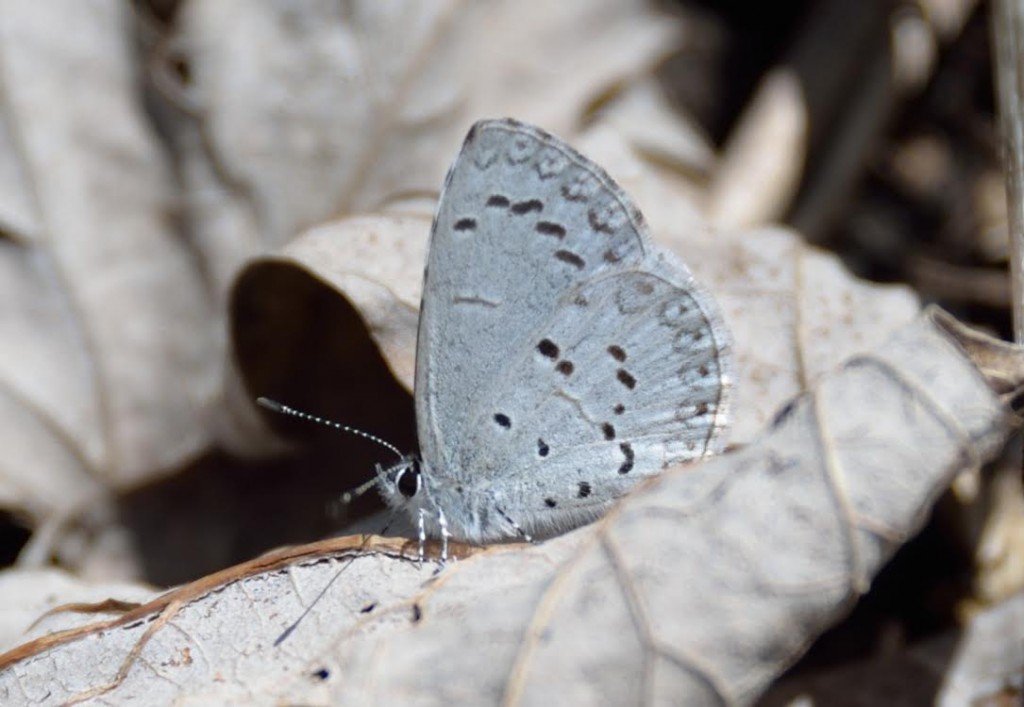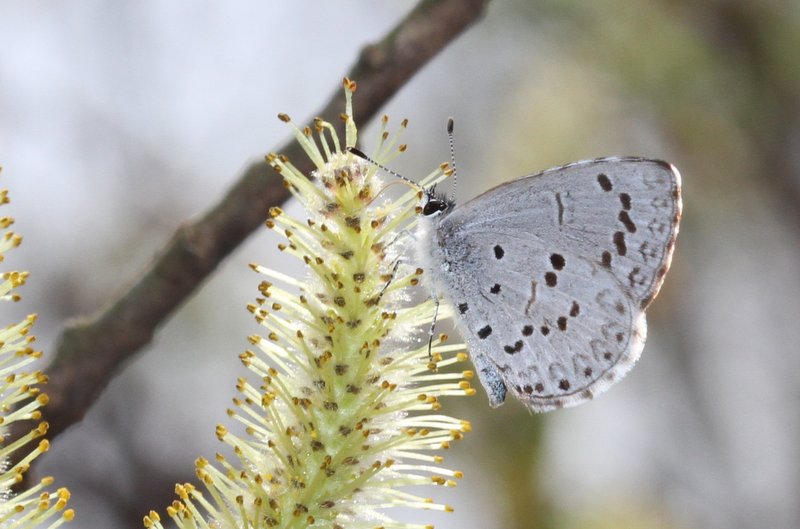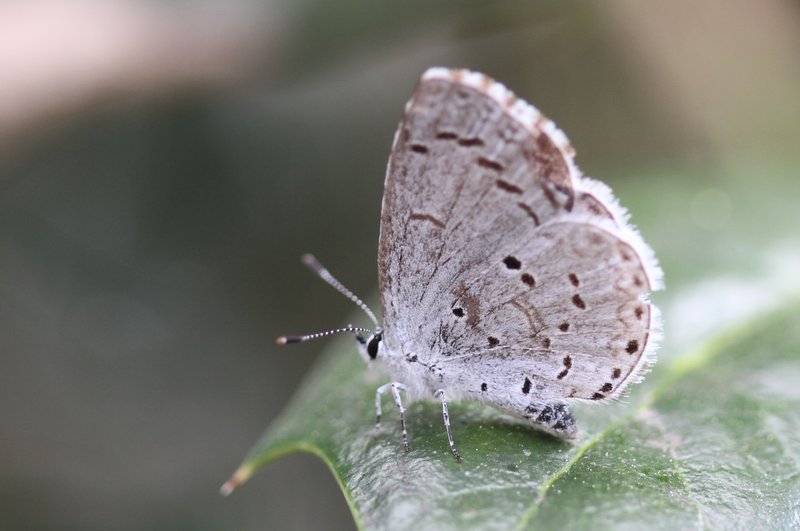
An apparent summer azure, spring form, photo’d by Gibson Reynolds in Saddlers Woods (CAM), April 16, 2014 (identification provided by David Wright)
From the spring of 2008 through the spring of 2013 we logged a total of fewer than half a dozen reports of summer azures in their spring form for all six years combined. As of April 18, we have 8+ certain or likely records of them in half a month.
Is 2014 an unusually good year for what we have assumed was a rare form in South Jersey? Or, is the difference in our “eyes”?
Are we finding more this year because some of our most careful observers are learning what to look for?
I have added “apparent” to these photos, because David Wright, who has very helpfully provided the IDs, uses qualifying words for each. He explains that it is very difficult to distinguish Celastrina neglecta in spring form from C. ladon, Edward’s azure, in those areas in South Jersey outside Pine Barren soils where dogwood (ladon‘s host) grows in the wild. On the Inner Coastal Plain, our western side — Salem, Gloucester, Camden, and parts of Burlington — C. ladon flies in early spring at the same time as C. neglecta. (Dogwood also grows here and there in the soils east of the Pine Barrens that extend up our easternmost edge from Cape May north along the thin slice of land that Witmer Stone called “The Coastal Strip.”)
The most reliable distinction between ladon and spring neglecta cannot be seen in photographs: it is a difference in their scale morphology, seen in hand by microscope.
David also has predicted a late emergence for holly azure, Celastrina idella, this year — based on the late winter and that both our common hollies — American holly (Ilex opaca) and inkberry holly (I. glabra) — are still in winter bud.
Here are two azures photographed by Dave Amadio in Gloucester County this week, confirmed by David Wright as apparent spring form/summer azures.

Apparent summer azure in spring form (nectaring on willow), photo’d by Dave Amadio at Wheelabrator WMA (GLO) on April 13, 2014.

Same individual as above, photo by Dave Amadio, April 13. (And a pretty shot of the willows as well!)

Apparent summer azure, spring form (a different individual than above) photo’d by Dave Amadio is his backyard in West Deptford (GLO) on April 14, 2014.

Same individual as above, showing top-side blue (and black margins that prove she is a female). Photo by Dave Amadio, April 14.
You can also see two photos of this form by Will Kerling at the previous post below.
If you like a challenge, go to the Pavulaan and Wright article at the link below and scroll to page 2, the plate of specimens, then hit the + sign a couple of times so that you can see the butterflies but cannot see their identifying captions. Can you find the one individual on the plate that best matches Gibson’s and Dave’s photos here: the one spring form/summer azure on the plate? Only one of the numbered specimens is that form.
For an even tougher test, you can try making your guesses at all five species on the plate. All four of our South Jersey species are illustrated, as well as one species not found in our area, C. neglectamajor, the Appalachian azure.
Some mnemonics that might help with the scientific names:
Blueberry azure = C. lucia [“blue suggests lu”]
Summer azure = C. neglecta [given that name originally because it had been neglected by science, and maybe our experiences this year on our log suggest we have been neglecting it as well, at least in spring]
Edward’s azure = C. ladon [“Ed is a lad”]
Holly azure = C. idella [ideal = perfection to Pavulaan & Wright, who named it]
Pavulaan and Wright’s 1999 paper describing C. idella, the holly azure
A shout-out here to Will Kerling for his contributions to the discussion and for passing along David Wright’s emails to him.
Comments, corrections, questions are welcome. Click “Leave A Comment” below.
Ok, that’s enough on this complex for now! Hopefully, we will shortly be celebrating duskywings and how easy they are to ID!
jc

I am enjoying the blogs, photos, and discussion of Celestrina species. As I study photos from two of Jack’s blogs, I find that I cannot see the definitive difference in the photo of C. Idella by Dave Amadio in “Here Comes the Challenge” (4/6/11), and the photos of a Summer Azures (C. neglecta) by Will Kerling (4/9/14) found in “Photo Forum 3” and photos of Summer Azures in “Photo Forum 3.1” by Gibson Reynolds (4/16/14) and Dave Amadio (4/13/14). Can anyone help me with this?
Not to cause trouble (knowing this board is for watchers and photographers), but the only way to really sort out the azure issue in S. Jersey is to voucher select specimens from a population and only then can they be studied in detail (top and bottom) under a scope. I know this may offend the sensibilities of many people, but this is one genus where collections are still awfully important, even if one sees 20 azures of the violacea type and vouchers a couple of the morphotype and sends them to a museum or insect collector who can get them off to an expert for opinions.
I collected many azures when I was in southern NJ a few years back, and all of the ones at Glassboro were C. lucia (Northern) except for one brilliant cobalt blue one with a white HW margin that may be true C. ladon (Edwards). All the azures I caught at Lakehurst were C. idella (Holly) and some C. lucia (Northern) early in the season. I do not have a single verified C. neglecta (Summer), until I get to late May and June when my Pennsylvania specimens are classic C. neglecta (Summer) with the whitish dusting on the HW. I have a few assumed C. neglectamajor (Appy) from areas with abundant Black Cohosh (even ovipositing on it) in PA, but specimens were indistinguishable in size from C. neglecta which also uses Cohosh.
These pure white azures underneath with grayish to small black spots all seem to be classic C. idella, but the violaceas with bigger, bolder dark spots seem to be something else. I am still perplexed how a single perched shot of the underside is able to distinguish idella/ladon/neglecta/serotina 100%. These interesting ones that appear to be spring neglecta SHOULD be collected to confirm their ID. We had the same issue in SC with spring neglecta but no one wants to pick up a net. It may be that idella IS the spring neglecta down there, as it is the only spring Celastrina I have collected on the SC coast.
Another note for NJ people… there is a small spring brood of Erynnis horatius that flies before juvenalis down south. I actually see horatius before juvenalis even emerges, and then they fly together for the spring. One must get a good look at the underside of these Erynnis and not just assume big spring Erynnis are Juvenal’s. The white spots on the lower HW are the only clincher as the gray scaling is highly variable.
Sorry for the essay but that is my opinion on these guys.